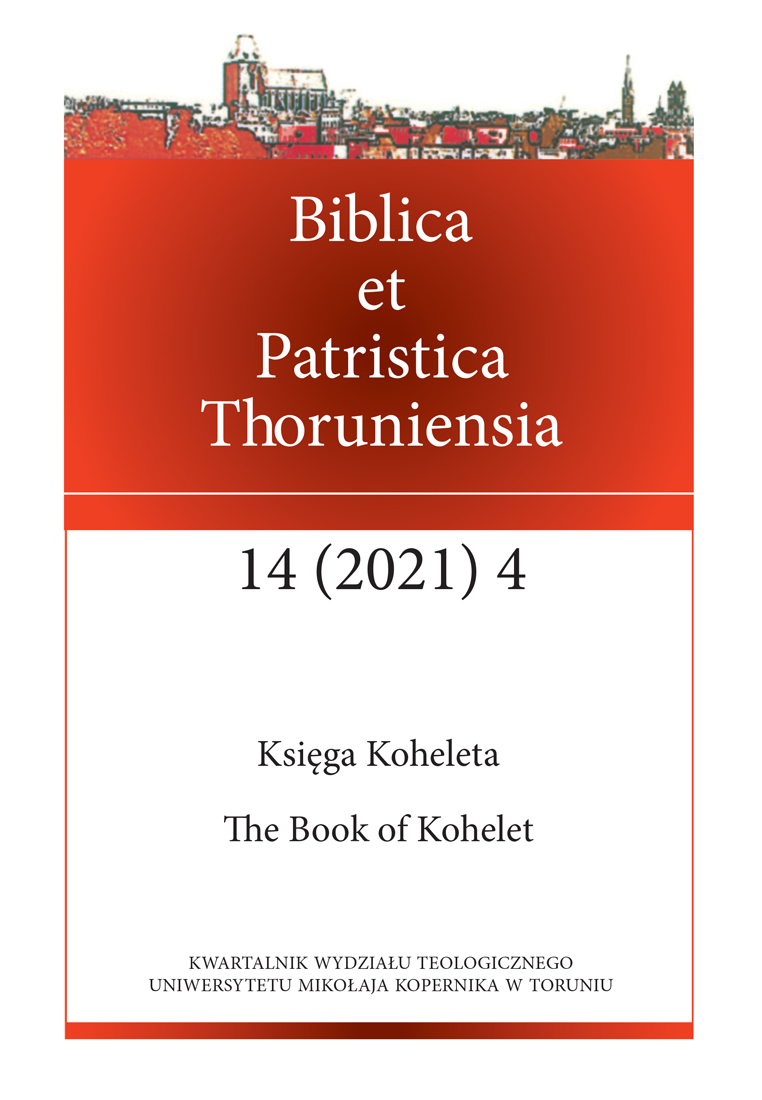La "mano" di Luca nella parabola del fariseo e del pubblicano (Luca 18,9–14)
DOI:
https://doi.org/10.12775/BPTh.2021.024Słowa kluczowe
Ewangelia wg św. Łukasza, praca redakcyjna św. Łukasza, przypowieść o faryzeuszu i celniku, przypowieść o synach w winnicyAbstrakt
"Ręka" w przypowieści o faryzeuszu i celniku (Łk 18,9–14) w Ewangelii według św. Łukasza
Celem artykułu jest odpowiedź na pytanie, czy Łk 18,9–14 przedstawia oryginalną tradycję sięgającą nauczania Jezusa, czy też fragment ten jest w całości dziełem trzeciego ewangelisty. Ponieważ przypowieść nie znajduje się w innych ewangeliach synoptycznych, które można porównać z tekstem św Łukasza, autor podchodzi do zagadnienia, najpierw studiując język przypowieści, a następnie omawiając możliwy kontekst, w którym przypowieść mogłaby zostać wypowiedziana. Następnie analizuje inne ewangelie synoptyczne, aby zobaczyć, czy istnieje podobna nauka, nawet jeśli nie ma bezpośredniego, równoległego fragmentu. Chociaż żaden z tych elementów rozważanych osobno nie jest wystarczający do ustalenia pochodzenia przypowieści, razem wzięte dostarczają przekonującego dowodu, że mogła ona mieć swój początek w nauce Jezusa.
Bibliografia
Aletti J.N., Il racconto come teologia, Roma 1996.
Bailey K.E., Poet & Peasant. Through Peasant Eyes, Grand Rapids 1983.
Bovon F., Das Evangelium nach Lukas, Neukirchen–Vluyn 2001.
Bultmann R., Die Geschichte der synoptischen Tradition, Göttingen 1958.
Cadeux A.T., The Parables of Jesus. Their Art and Use. London 1930.
Chrupcała L.D., "La prassi orante di Gesù nella catechesi lucana," LA 49 (1999) 101–136.
Denaux A., Corstjens R., Mardaga H., The Vocabulary of Luke. An Alphabetical Presentation and a Survey of Characteristic and Noteworthy Words and Word Groups in Luke’s Gospel. Leuven 2009.
Dibelius M., Die Formgeschichte des Evangeliums, Tübingen 1959.
Dupont, J., Il metodo parabolico di Gesù, Brescia 1978.
Eckey W., Das Lukasevangelium, Neukirchen–Vluyn 2004.
Ellis E.E., The Gospel of Luke, Grand Rapids–London 1981.
Fitzmyer J.A., The Gospel according to Luke, New York 1985.
Grundmann W, "ταπεινός", GLNT, XIII, 822–892.
Hultgren, A.J., Le parabole di Gesù, Brescia 2004.
Jeremias J., Die Sprache des Lukasevangeliums, Göttingen 1980.
Jeremias J., Le parabole di Gesù, Brescia 1973.
Jülicher, A., Die Gleichnisreden Jesu. Zwei Teile in einem Band, Darmstadt 1976.
Kilgallen J.J., “The Importance of the Redactor in Luke 18:9–14”, Biblica 79 (1998) 69–75.
Kudasiewicz J., Ewangelie synoptyczne dzisiaj, Ząbki 2006.
Làconi M., "Introduzione speciale," 133–196, in Làconi M. (a cura di), Vangeli sinottici e Attidegli Apostoli, Torino 1999.
Linnemann E., Gleichnisse Jesu, Göttingen 1961.
Marshall I.H., The Gospel of Luke, Exeter 1978.
Meier J.P., A Marginal Jew.Probing the Authenticity of the Parables. New Haven 2016.
Mickiewicz F., Ewangelia według świętego Łukasza, NKB.NT III/2, Częstochowa 2012.
Nolland J., Luke 9:21–18:34, Dallas 1993.
Prete B., Le parabole della preghiera nel Vangelo di Luca, Torino 2003.
Rakoczy W., Obraz i funkcja faryzeuszy w dziele Łukaszowym (Łk–Dz). Studium literacko-teologiczne, Lublin 2000.
Rossé G., Il vangelo di Luca, Roma 2001.
Sanders J.T., The Jews in Luke-Acts, London 1987.
Schnackenburg R., Il messaggio morale del Nuovo Testamento, Brescia 1989.
Schottroff L., "Die Erzählung vom Pharisäer und Zöllner als Beispiel für die theologische Kunst des Überredens", 439–461, in Braun H., Betz H.D., Schottroff L., Neues Testament und christliche Existenz. Festschrift für Herbert Braun zum 70. Geburtstag, Tübingen 1973.
Schweizer E., Il vangelo secondo Luca, Brescia 1999.
Snodgrass K.R., Stories with Intent. A Comprehensive Guide to the Parables of Jesus. Grand Rapids 2008.
Stefaniak L., "Przypowieści o modlitwie w Ewangelii św. Łukasza," Ruch Biblijny i Liturgiczny 8 (1955) 84–107.
Zimmermann R., Compendio delle parabole di Gesù. Brescia 2011.
Pobrania
Opublikowane
Jak cytować
Numer
Dział
Licencja
Prawa autorskie (c) 2021 Piotr Blajer

Utwór dostępny jest na licencji Creative Commons Uznanie autorstwa – Bez utworów zależnych 4.0 Międzynarodowe.
CC BY ND 4.0. Posiadaczem prawa autorskiego (Licencjodawcą) jest Autor, który na mocy umowy licencyjnej udziela nieodpłatnie prawa do eksploatacji dzieła na polach wskazanych w umowie.
- Licencjodawca udziela Licencjobiorcy licencji niewyłącznej na korzystanie z Utworu/przedmiotu prawa pokrewnego w następujących polach eksploatacji: a) utrwalanie Utworu/przedmiotu prawa pokrewnego; b) reprodukowanie (zwielokrotnienie) Utworu/przedmiotu prawa pokrewnego drukiem i techniką cyfrową (e-book, audiobook); c) wprowadzania do obrotu egzemplarzy zwielokrotnionego Utworu/przedmiotu prawa pokrewnego; d) wprowadzenie Utworu/przedmiotu prawa pokrewnego do pamięci komputera; e) rozpowszechnianie utworu w wersji elektronicznej w formule open access na licencji Creative Commons (CC BY-ND 3.0) poprzez platformę cyfrową Wydawnictwa Naukowego UMK oraz repozytorium UMK.
- Korzystanie przez Licencjobiorcę z utrwalonego Utworu ww. polach nie jest ograniczone czasowo ilościowo i terytorialnie.
- Licencjodawca udziela Licencjobiorcy licencji do Utworu/przedmiotu prawa pokrewnego nieodpłatnie na czas nieokreślony
PEŁEN TEKST UMOWY LICENCYJNEJ >>
Statystyki
Liczba wyświetleń i pobrań: 1131
Liczba cytowań: 0



